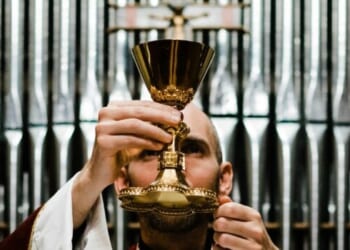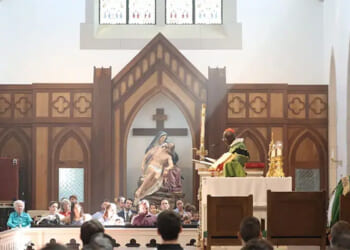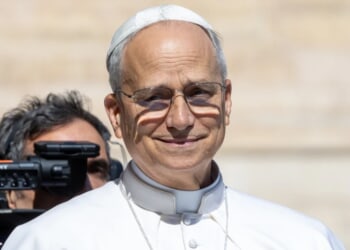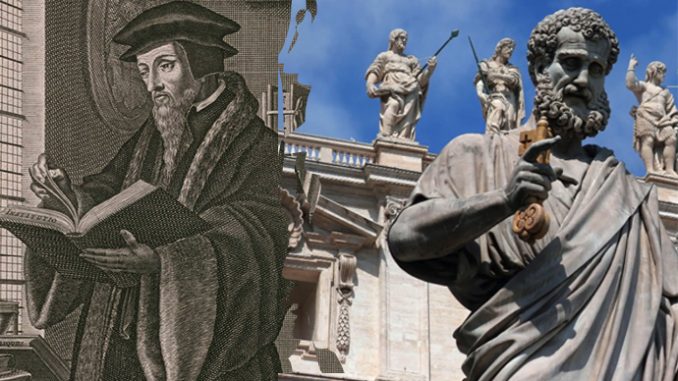
/ Unsplash.com)
Unless you pay much attention to the tiny subculture that is Catholic-Calvinist ecumenical debate and apologetics, you likely wouldn’t know that the discussions can get quite heated and personal. When one respected Presbyterian pastor and writer (and friend of mine) converted to Catholicism more than a decade ago, some Calvinists (including a few famous ones) engaged in a series of public attacks on his character and reputation. My own recent book, The Obscurity of Scripture, which critiques the Protestant doctrine of perspicuity, has provoked more than a few unkind words from my former brethren in the Calvinist tradition, including charges that I have committed blasphemy, am deceived by the devil, and am even going to hell.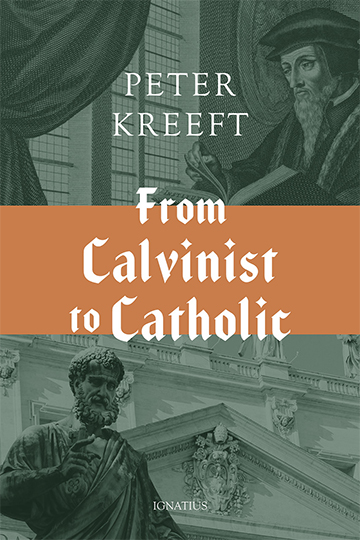
It is therefore refreshing to read Peter Kreeft’s new spiritual autobiography, From Calvinist to Catholic. It offers a very sympathetic portrayal not only of the Boston College philosophy professor’s upbringing in a Dutch-American Calvinism, but also the beliefs and practices of Calvinists.
Filled with Kreeft’s characteristic humor and cleverness, the philosopher sprinkles wisdom throughout his story, while those familiar with his oeuvre (which numbers more than a hundred books) will welcome getting to know a little more about the man himself.
Kreeft’s beginnings
A native of Paterson, New Jersey, an old mill town with a once large, ethnically Dutch population, Kreeft grew up an only child in a serious Calvinist household. Church was a Sunday morning and evening activity, and prayer and Bible reading preceded every meal. His family’s social network was almost entirely ethnic Dutch members of the Reformed Church in America or the Reformed Church in America.
Tribal loyalties and provincialism persuaded Kreeft to have quite a negative view of the Catholic Church: the pope was the Antichrist and the Church itself the “whore of Babylon” described in Revelation. In his senior year of high school, Kreeft won a prize for an anti-Catholic essay on Dostoevsky’s chapter on “The Grand Inquisitor” in The Brothers Karamazov.
He then went on to attend the Calvin College in Grand Rapids, Michigan, where most of his philosophy professors argued that reason itself is fallen, untrustworthy, and pagan (a bit of an unstable position to hold if you’re trying to make an argument based on something more than sentiment or sheer force of will). Thankfully, one philosophy professor was much better in both his philosophy and pedagogy, refusing to help his students identify errors in the writings of Enlightenment philosopher David Hume because it would rob students of the opportunity to do their own work.
Kreeft’s questions (and answers)
Nevertheless, the precocious young Kreeft had questions that presaged his eventual conversion. He once asked his father how God could permit all the other Protestant denominations, despite their similarities to their particular Dutch Reformed denomination, to be wrong, while theirs was right (the unspoken follow-up question being “How do we know we’re right, and everyone else is wrong?”). Indeed, Kreeft reasoned, the biggest “denomination” was the Catholic Church, and yet it seemed strange that the Holy Spirit would do its work “so badly.”
He also noticed that Catholic churches were the most beautiful of those he visited in the United States. “Why had God allowed the throne room of the Queen of Heaven to be owned by the Whore of Babylon? But the cathedral was a reality, it was data, it was unarguable.” There seemed to be no argument against the beauty Kreeft witnessed in the Catholic Church.
Of course, as a philosopher, Kreeft also has more than aesthetic arguments to explain his conversion. The fundamental reason, he explains, was “the historical fact that Jesus Christ established the Catholic Church and gave her His authority.” He observes that many of the alleged “accretions” Catholics hold as doctrine—such as the primacy of the Bishop of Rome, the Eucharist as the center of weekly worship, the Real Presence of Christ, the Mass as a sacrificial offering, devotion to the saints and to Mary, Baptism as salvific, Apostolic Succession, and the authority of Apostolic Tradition—caused little, if any, protest or controversy until the Protestant Reformation in the sixteenth century.
Moreover, Kreeft (rightly) notes that one does not need to prove all the doctrines of the Church in order to convert, only that the Church is who she claims to be. If the historicity of apostolic succession can be demonstrated, that is enough to prove that the Church acts with the authority of Christ Himself. “The onus of proof,” he writes, “was on the non-Catholic to refute the one deductive argument rather than on the Catholic to prove the many inductive arguments.”
Yet as a student of Aquinas, Kreeft knows it is tremendously helpful to anticipate objections and work through them. He thus addresses what he assesses to be seven significant anti-Catholic criticisms of this position. These include that many Catholics do not know what is necessary for salvation; that the Catholic view of the sacraments makes them seem like magic; that veneration of Mary obscures Christ; and that the Catholic Church has always been an institution defined by corruption and tyranny.
Regarding the last, Kreeft wryly cites a story from Boccaccio’s Decameron, in which one man asserts that “no merely earthly business that stupid and corrupt” could last as long as the Catholic Church apart from divine intervention.
In studying Christian history, Kreeft asks an important question. Who were the heretics: Catholics or Protestants? On this point, the Catholic philosopher appeals to the four marks of the Church: unity, holiness, catholicity, and apostolicity. Consider unity: while there is a single Catholic Church, there is no such thing as “the Protestant church” but a complicated, confusing number of Protestant ecclesial communions, often with views diametrically opposed to one another. Moreover, in response to the allegations of ecclesial corruption, which has indeed often been quite atrocious, Kreeft responds: “No matter how badly the Church lived her teachings, she never un-taught them.” Jesus made precisely the same point when he exhorted his audience to obey the Pharisees but not to follow their immoral example (Mt. 23:3).
I particularly enjoyed Kreeft’s critique of sola scriptura. He argues that it violates the principle of causality because the effect cannot exceed the cause. How can a supposedly fallible cause (namely, the early Church) somehow write an infallible Bible? That argument may not appeal to many Protestants uninterested in or suspicious of philosophy, but to anyone who adheres to Aristotelian logic (which some Protestants do), it does present quite a conundrum.
His chapter on the five points of Calvinism is also illuminating, though I wish he had in some places offered a bit more thorough explanation of his reasoning. For example, in his repudiation of unconditional election—the Calvinist idea that God first elects some and not others to be saved, giving grace to the former and predestining the latter to damnation—Kreeft argues that this error “puts God in time, in a before-and-after cause-and-effect relationship.” Yet those not schooled in the basics of philosophy may scratch their heads and ask, “So what?” He is better on irresistible grace, the Calvinist idea that the individual cannot resist divine grace; the problem with such an idea is that if grace is irresistible, then there is no free will.
One of his best chapters is on Mary, in which he observes that it is curious how much Protestants have an aversion to venerating Mary. Yet, ironically, radical feminists also hate, fear, or deny Mary. Of course, these two groups’ antagonism towards honoring Mary manifests itself quite differently: Protestants view Marian veneration as an obscuring of the singular worship due to God alone, while radical feminists see Mary in her weakness, receptivity, and humility as an obstacle to self-realization. Yet both reflect a certain repudiation of God’s order: secular feminists on the natural level, and Protestants on the divine level.
Kreeft the ecumenist
As a former Presbyterian seminarian, I was grateful to see Kreeft dispel several unfair caricatures of Calvinists, such as the supposed Calvinist doctrine that hard work and material prosperity are a sign of predestination (I was certainly never taught this). Indeed, notes Kreeft, Dutch Calvinists, either when they are rich, pretend to be poor, treating wealth with embarrassment.
He also praises Calvinists for their emphasis on the absolute sovereignty of God and the comforting words found at the beginning of the Heidelberg Catechism: “What is your only comfort in life or in death?” “That both in life and in death I belong to my faithful Savior Jesus Christ.” And though according to Catholic teaching Calvinism is a heresy, Kreefly rightly acknowledges: “It is usually one half of a difficult paradox without the other half… it is as important to keep and cherish the positive truth in a heresy as it is to avoid the negative error; it is as crucial to keep the true version as it is to reject the perversion.”
Though Catholic thinkers loom large in Kreeft’s account of his conversion, he gives pride of place to the Anglican C.S. Lewis, whom he describes as the author who most shaped his own thinking. Kreeft recommends Lewis’s The Abolition of Man as an excellent, must-read text, especially in engaging with a secular world that is increasingly removed from the realities of natural law that should be obvious to them.
Kreeft the curiosity
Kreeft possesses a commendable penchant for making the esoteric accessible, which can disguise his brilliance. But as we learn in From Calvinist to Catholic, he was reading St. John of the Cross as a teenager. He is also quite the comedian, and the chapters are peppered with amusing stories and the type of bluntness characteristic of his writing and speaking style. “I nominate Facebook for an award for being the most insufferably egotistical enterprise and the biggest waste of time in human history,” Kreeft asserts early in the book.
While an undergraduate at Calvin College, Kreeft served cat food on crackers as hors d’oeuvres at a party. He jokes that he dated rarely at Calvin because he found the girls there boring in either mind or body—“God apportions His gifts very parsimoniously; perhaps He is a Dutch Calvinist.” His narrative can jarringly shift from serious theology to coarse language. And in a somewhat strange set of circumstances, Kreeft ended up marrying his godmother (she was one of only a few Catholic friends when he was baptized as a Catholic, and they had to get a special dispensation from Rome in order to marry in the Church).
The book could have used a bit more editing; we read of the same exchange with a young friend regarding praying to the saints in two separate chapters. Kreeft’s tendency to make broad, sweeping statements also sometimes overreaches. He claims that no self-identifying Christian rejected the Real Presence of Christ in the Eucharist until Berengar of Tours around A.D. 1000. That seems a difficult thing to prove, especially given that the heresies of Gnosticism (which rejected God as coming in the flesh) and Arianism (which claimed Jesus to be a creature rather than co-eternal with the Father), if not explicitly at least effectively denied that doctrine.
Nevertheless, these are minor criticisms of an otherwise excellent and often entertaining religious autobiography. Though it may not present the type of detailed defenses of doctrines necessary to answer all Protestant objections to such doctrines as the Eucharist or the communion of saints, it is a useful and irenic introduction to the Catholic position from one of its most effective apologists of the past half-century. And those interested in learning more from the almost nonagenarian have quite a corpus to choose from.
From Calvinist to Catholic
By Peter Kreeft
Ignatius Press, 2025
Hardcover, 192 pages
If you value the news and views Catholic World Report provides, please consider donating to support our efforts. Your contribution will help us continue to make CWR available to all readers worldwide for free, without a subscription. Thank you for your generosity!
Click here for more information on donating to CWR. Click here to sign up for our newsletter.



